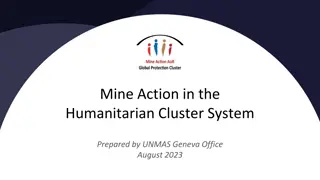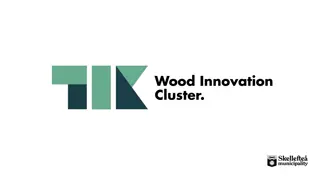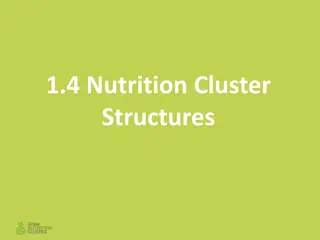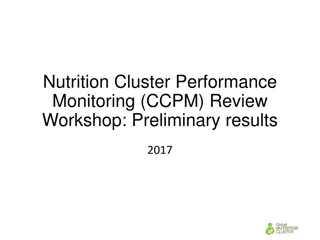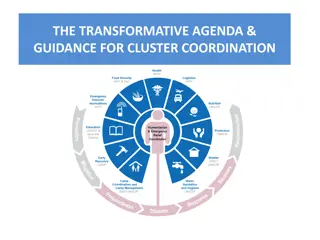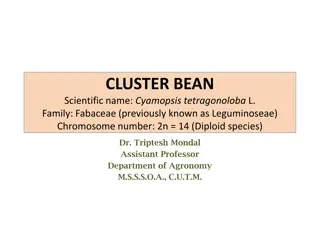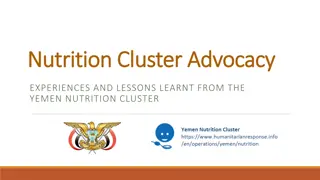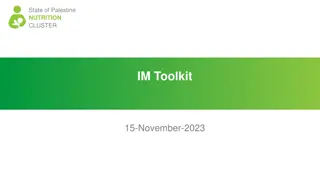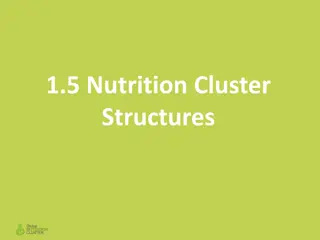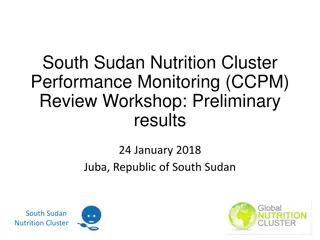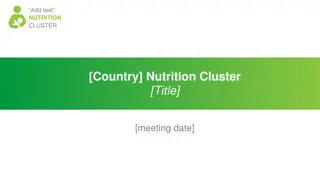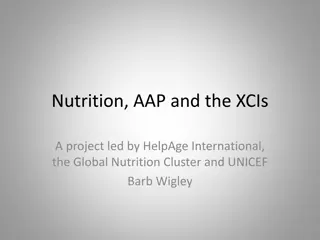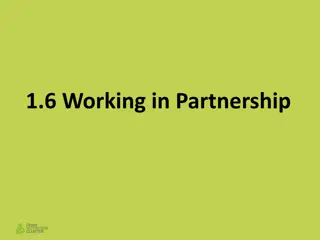Nutrition Cluster Core Functions Overview
The content provides a detailed overview of the core functions of the Nutrition Cluster, focusing on objectives, core functions, group work activities, and explanations on supporting service delivery, informing strategic decision-making, and advocacy. It highlights the importance of cluster coordination, partnership commitments, capacity building, and monitoring and evaluation within the context of nutrition clusters at national and sub-national levels.
Download Presentation

Please find below an Image/Link to download the presentation.
The content on the website is provided AS IS for your information and personal use only. It may not be sold, licensed, or shared on other websites without obtaining consent from the author.If you encounter any issues during the download, it is possible that the publisher has removed the file from their server.
You are allowed to download the files provided on this website for personal or commercial use, subject to the condition that they are used lawfully. All files are the property of their respective owners.
The content on the website is provided AS IS for your information and personal use only. It may not be sold, licensed, or shared on other websites without obtaining consent from the author.
E N D
Presentation Transcript
1.3 The Nutrition Cluster Core Functions
Objectives of this Session By the end of this session, participants will be able to: Describe the Cluster Core Functions with a focus on AAP Explain how Cluster Core Functions relate to the Nutrition Cluster at the national and sub-national level.
Core Cluster 6 +1 Functions Support service delivery Inform strategic decision- making Advocacy AAP Plan and implement cluster strategies Build national capacity Monitor and evaluate performance
Group Work: Core Cluster Functions Quiz Complete the Core Cluster Functions Quiz in pairs. Enter the number of the Core Cluster Function(s) that match the description on your quiz.
1. Support service delivery What does this mean? Cluster Coordination Team Establish regional coordination platform(s) HR/TORs Reporting lines SAG, TWG Up-to-date mailing list Cluster Actions: Providing a platform that ensures service delivery is driven by the Humanitarian Response Plan and strategic priorities. Cluster Partners Partner Commitment TOR Participation SAG/TWG HR/Co-chair
1. Support service delivery What does this mean? Cluster Coordination Team Identification of unmet needs 3/4 W Database Analysis of 3/4 W matrix Mapping/output Dissemination of products Cluster Actions: Developing mechanisms to eliminate duplication of service delivery. Cluster Partners Agreement on format Reporting Analysis Contribution to outputs
2. Inform HC/HCTs strategic decision-making What does this mean? Cluster Coordination Team Design and harmonization of assessment methods/tools Databases Consolidate data Cluster Partners Participate in design and harmonization of assessments Capacity building Cluster Actions Prepare needs assessments and analysis of gaps to inform the setting of priorities.
2. Inform HC/HCTs strategic decision-making What does this mean? Cluster Coordination Team Coordinate assessments Analyse information (across and within sectors) Identify gaps and conduct capacity mapping Advocate for gap-filling Cluster Partners Participate in assessments Collaborative analysis of gaps and capacity Cluster Actions Identify and find solutions for gaps, obstacles, duplication and cross- cutting issues.
2. Inform HC/HCTs strategic decision-making What does this mean? Cluster Coordination Team Coordinate cluster contribution into HNO and cluster-specific response priorities Coordinate the estimation of people in need/caseloads Cluster Actions Formulating priorities on the basis of analysis Cluster partners Participate in analysis to inform HNO and cluster-specific response priorities
3. Plan and implement cluster strategies What does this mean? Cluster Coordination Team Coordinate cluster response planning/input into HRP Discussion on needs, targets, strategic objectives Indicators Development of Operational plan Clarify Roles and Responsibilities Cluster Actions Develop sectoral plans, objectives and indicators to support the overall response s strategic objectives. Cluster Partners Support response planning Develop Cluster Operational Plan TWG/SAG
3. Plan and implement cluster strategies What does this mean? Cluster Coordination Team Adaptation of programmatic guidance Alignment with national standards Technical capacity mapping Advocacy to cluster partners and CLA to fill gap TWG/SAG Cluster Actions Apply and adhere to common standards and guidelines. Cluster Partners Participate in adaptation/harmonization of guidelines Adherence and application Support capacity building
3. Plan and implement cluster strategies What does this mean? Cluster Coordination Team Coordinate costing of the Cluster HRP Coordinate prioritization of country pooled funds within cluster Cluster Actions Clarify funding requirements, helping to set priorities, and agreeing cluster contributions to the HC s overall humanitarian funding proposals. Cluster Partners Contribute to costing exercise Support pooled fund prioritisation (participation in project review committee) Report on funding status
4. Monitor and evaluate performance What does this mean? Cluster Actions Monitoring and reporting on activities and needs. Measuring progress against the cluster strategy and agreed results. Recommending corrective action where necessary Cluster Coordination Team Development of cluster M&E Framework Reporting format Tracking regularity of reporting Analysis and feedback/recommendations to partners Dissemination of reporting trends Cluster Partners Contributing in the above Timely reporting Joint analysis of trends and facilitating corrective action
5. Build national capacity in preparedness and contingency planning What does this mean? Cluster Actions In preparing for and responding to an emergency, international humanitarian actors are expected to cooperate with national authorities and support national capacity wherever it is feasible and appropriate to do so. Cluster Coordination Team Support Contingency/preparedness planning Analysis and early warning reports Coordinate capacity-building initiatives Support coordination training for national counterparts Cluster Partners Participate in the above Contribute to capacity building initiatives
6. Support robust advocacy Cluster Actions Identifying concerns, and contributing key information and messages to HC and HCT messaging and action. Undertaking advocacy on behalf of the cluster, cluster members, and affected people. What does this mean? Cluster Coordination Team Consolidation of evidence Support development of shared analysis and advocacy strategy (including key advocacy messages) Develop nutrition cluster advocacy workplan Monitor impact of specific advocacy processes with government and partners Cluster Partners Share analysis and support development of advocacy strategy and workplan Contribute to/be represented at nutrition cluster advocacy activities
+ Accountability to Affected People Cluster Actions Mechanisms to consult and involve affected people in decision-making agreed upon and used by partners Mechanisms to receive, investigate and act upon complaints on the assistance received agreed upon and used by partners Key issues relating to PSEA have been raised and discussed What does this mean? Review and assess cluster partners capacities to implement complaints and feedback mechanisms Promote common approaches to engaging with communities, including joint feedback and complaints mechanisms. Ensure that all cluster partners are aware of and know procedures for dealing with sensitive issues and complaints, including PSEA. Promote regular discussions of feedback from affected people and ensure any actions or decisions are shared back to communities.
All this contributes to responses that Are appropriate and relevant Are timely and effective Strengthen local capacities and avoid negative effects Are based on communication, participation and feedback Provide safe and accessible complaints and response mechanisms Are coordinated and complementary Support continuous learning and improvements Are delivered by competent staff Use resources efficiently and effectively
Key Messages: Cluster Core Functions revolve around supporting better outcomes and accountability to affected people The core functions help ensure partners align their work towards collective and coordinated approaches The functions form the basis of how a cluster works together, and include issues beyond implementation







